

RE-INDUSTRIAL CITY
scenario for a postfossil industrial society
Arthur van der Laaken | graduation project | Academie van Bouwkunst Amsterdam | urbanism | 2024RE-INDUSTRIAL CITY
scenario for a postfossil industrial society
ARTHUR VAN DER LAAKEN




TABLE OF CONTENT
Energy and pollution of (secondary) industries
Import Export
Proloog NL
Prologue EN
PART | : RE-INDUSTRIAL CITY
Introductietext NL: RE-Industrië Stad
Introduction text EN: RE-Industrial City
Concept and method
Postfossil Tata Steel
Urban plan
Reflection on time, society and economy
PART || : (PRE-) FOSSIL LOGIC
Timeline: energy, systems and space
History and logic of dunes and steel industry in NL
(pre-) fossil mechanisms
PART ||| : POSTFOSSIL LOGIC
Industry consumes half of the available energy in NL


Air pollution NL 10 largest polluters NL
CO2 (Carbon dioxide)


NO2 (Nitrogen)






Water pollution NL







Fossil logic: small world, big systems


IMPORT: iron ore + coals from Brasil, South Africa, Indonesia and Australia



Fossil logic: small world, big systems
EXPORT: iron scrap from NL > 5000T p/d to Turkey, Egypt and India


Proloog: Lokaal hout is ver te zoeken Voor mijn vakantiehuisje op de Veluwe wilde ik ooit een veranda bouwen. Zo zou je op je sloffen direct het bos in kunnen stappen voor een ontbijt met vogelgezang. Om de relatie met dat bos te versterken leek het me logisch om hout uit de omgeving te gebruiken, dat was immers ruimschoots aanwezig. Niet veel verderop werden productiebomen gerooid.
Bij geen van de bouwmarkten en houthandels in Arnhem kon ik Veluws hout vinden. De rekken lagen vol Afrikaans Padoek, Braziliaans Tatajuba en zachtere soorten afkomstig uit Polen en Zweden. Medewerkers van de winkels konden mij ook niet verder helpen in mijn zoektocht.
Toch had ik geluk. Na tal van omzwervingen op internet trof ik één houtspecialist die had wat ik zocht. Ruim zestig kilometer verderop laadde ik mijn aanhanger vol planken van douglassparren, afkomstig van de Utrechtse Heuvelrug. Écht lokaal was het dus niet, maar goed genoeg voor mijn ontbijt.
Prologue: Local wood is far to find
For my vacation cabin in the Veluwe, I once wanted to build a porch. This way, you could step directly into the forest for a breakfast with birdsong. To strengthen the connection with that forest, it seemed logical to me to use wood from the area, as it was abundantly available. Not far away, production trees were being felled.
At none of the hardware stores and lumber yards in Arnhem could I find Veluwe wood. The shelves were filled with African Padauk, Brazilian Tatajuba, and softer types from Poland and Sweden. Employees of the stores couldn’t help me further in my search.
Yet, I was lucky. After numerous searches on the internet, I found one wood specialist who had what I was looking for. Over sixty kilometers away, I loaded my trailer with planks of Douglas firs, originating from the Utrechtse Heuvelrug. It wasn’t truly local, but good enough for my breakfast.
1_RE-Industriële Stad
Scenario voor een postfossiele industriële samenleving
Groots, ondoorgrondelijk, ontoegankelijk, en buiten menselijke maat, er bestaan in Nederland ontzagwekkende industriecomplexen die met regelmaat het nieuws domineren: Tata Steel, Chemelot, Chemours, Shell. Allemaal bedrijven die de leefomgeving van mens en dier iedere dag ongezonder maken. Ze roepen de nodige vragen bij me op.
Hoe kan het dat deze (secundaire) industriële reuzen in weerwil van hun desastreuze invloed op de omgeving blijven bestaan? Nota bene in een van de rijkste en dichtst bevolkte landen ter wereld. En wat zal er met hun gebeuren gedurende de energietransitie? Zijn ze levensvatbaar zonder fossiele brandstof?
Ik heb me verdiept in diverse plannen om secondaire industrie te verduurzamen, maar de achterliggende logica en de omvang van ketens waar ze onderdeel van uitmaken worden niet of nauwelijks ter discussie gesteld. Ieder verduurzamingsrapport blijkt teleurstellend.
Biedt de grote transitie naar fossielvrije energie niet veel meer kansen dan alleen technisch vernuft in lithium, waterstof en CO2 opslag? De fossielvrije toekomst wordt kennelijk geënt op een fossiele stam. Maar is het logisch om een
systeem dat is geworteld in fossiele energie als basis te gebruiken voor een ‘duurzaam’ equivalent?
Wanneer deze industriecomplexen het ruimtelijke gevolg zijn van een systeem op basis van fossiele grond- en brandstoffen, rijst de vraag: hoe zouden de ruimtelijke manifestaties er uit kunnen zien van een postfossiel systeem? In dit project heb ik de relaties van beide systemen en hun ruimtelijke implicaties onderzocht om te kijken welke kansen en mogelijkheden de mondiale energietransitie biedt voor grote industriële complexen in Nederland.
Uit dit onderzoek blijken systeem en ruimte onlosmakelijk met elkaar verbonden. Om te beginnen ben ik eerst op zoek gegaan naar een postfossiele logica. Daar vanuit zijn ruimtelijke relaties ontstaan tussen stad en industrie, die vervolgens de basis vormden voor mijn stedenbouwkundig plan. Op basis hiervan heb ik een methode ontwikkeld met perspectief op de transitie naar een postfossiel tijdperk voor een industriële samenleving in een dichtbevolkt gebied.
Ik ga er in mijn ontwerp vanuit dat we in de toekomst minder energie en grondstoffen beschikbaar zullen hebben dan nu. Tegelijk zijn werkgelegenheid, economische activiteit,
welzijn en ecologie in het plan geen concurrerende, maar juist samenwerkende krachten die elkaar versterken.
Dit boek is een documentatie van dat proces. Navolgend een schets van de kernpunten voor een postfossiele industriestad.
Stad en industrie
Stad en industrie zijn toe aan een nieuwe relatie. Waar vóór de komst van fossiele brandstoffen industrie kleinschalig en fijnmazig verweven was met de stad, werden deze met de komst van fossiele energie uit elkaar getrokken. De industrie werd te groot en vervuilend en verplaatste zich naar de periferie. Deze scheiding is vanuit een postfossiel perspectief onnodig en inefficiënt. Industrie is dan namelijk niet langer vervuilend, en bovendien minder groot. De dagelijkse reisafstanden - dus ook van forenzen - worden kleiner. Steden blijven afhankelijk van industriële processen en zullen zodoende een re-industrialisatie doormaken.
De bestaande huidige complexen bieden unieke en aantrekkelijke mogelijkheden om stad en industrie opnieuw samen te brengen. Een postfossiele industriestad heeft een eigen logica en levert een totaal nieuwe stedelijke typologie
en morfologie op: de RE-Industriële Stad.
Herlokaliseren, herwaarderen, herstellen De RE-Industriële Stad gaat uit van drie ruimtelijke uitgangspunten: Herlokaliseren, Herwaarderen en Herstellen.
Herlokaliseren - Het herlokaliseren gaat op voor zowel de systeemschaal van grondstoffen en producten, als voor de schaal van de alledaagse stad. Systemen en ketens van energie, voedsel en grondstoffen worden zo klein mogelijk, maar zo groot als nodig. Dat betekent meer lokale productie en korte ketens. In de alledaagse stad worden afstanden beperkt tot een minimum waarbinnen de beoogde doelen te voet en per fiets bereikbaar zijn. Goederen worden binnen de stad per microtransport verplaatst.
Herwaarderen - Omdat er in de toekomst minder energie voorhanden is moeten we, waar mogelijk, uitgaan van bestaande bouwstructuren. Afgezien van het feit dat hergebruik minder energie vergt, dragen deze structuren in een nieuwe context bij aan een gelaagd ruimtelijk beeld dat de identiteit versterkt. Ook de aanwezige infrastructuur op bestaande industriecomplexen kunnen in een nieuwe situatie als zodanig dienst doen.
Herstellen - Veel grote industriecomplexen hebben in de loop van tijd rücksichtslos de oorspronkelijke ecologische en landschappelijke structuren genegeerd en verwoest.
In de RE-Industriële Stad worden deze structuren zoveel mogelijk hersteld en als uitgangspunt genomen voor een landschappelijke basis.
cessen die samenwerken en elkaar versterken. Er is minder directe relatie met de andere kant van de wereld, maar er zijn meer relaties binnen de regio. Zo vormt industrie in de toekomst een lokale biotoop in samenwerking, vergelijkbaar met de natuurlijke processen in een bos.
Één systeem van synergieën
Wanneer ik door het bos loop ben ik telkens gefascineerd door de samenhang van alles wat daar leeft. De bomen zijn geen op zichzelf opererende entiteiten, evenmin als de aanwezige heesters, mossen, schimmels en dieren. Ze vormen in hun onderlinge samenwerking één levend organisme als geheel. Tijdens mijn onderzoek begon ik het bos steeds meer als voorbeeldmodel te zien voor een postfossiel systeem.
In ons traditionele fossiele systeem verlopen productieprocessen wereldwijd conform economische spelregels en belangen ten aanzien van beschikbare grondstoffen, terwijl verbanden op lokaal niveau steeds meer zoek raken. Verschillende systemen functioneren hier vooral naast elkaar. De postfossiele industriestad vormt een biotoop van pro-
In een postfossiele samenleving hebben we alleen bovengrondse grond- en hulpstoffen tot onze beschikking, of dat wat we daarvoor al uit de grond hebben gehaald. Dat betekent dat we naar een circulair systeem overstappen.
Recentelijk is de zogeheten R-ladder ontwikkeld, een schema waarbinnen de mate van circulariteit van een product meetbaar is gemaakt. Dit model wordt momenteel veelal toegepast in de ontwikkelingen van circulaire economie.
Om een postfossiele industriestad vorm te geven heb ik de R-ladder vertaald naar een ruimtelijk raamwerk van R-ruimtes. Aan alle R-waarden uit de R-ladder heb ik ruimtelijke en programmatische uitgangspunten gekoppeld. Samen vormen zij de bouwstenen voor een volledig circulaire industriestad. Alle R-ruimtes liggen in elkaars nabijheid (herlokaliseren) en zijn onderling verbonden. In de samenwerking ontstaat één systeem van synergieën.
Transitie Tata Steel
In de toekomst zal er geen toevoer van (ondergrondse) grondstoffen meer zijn bij Tata Steel. In de nieuwe fabrieken zal alleen schroot worden omgesmolten in elektrische smeltovens. Er is in Nederland genoeg schroot in omloop om een lokale (landelijke) staalindustrie te voeden. Alle energie die hiervoor nodig is komt van windturbines op zee (dit proces kost aanzienlijk minder energie dan het huidige systeem om te bouwen naar waterstof). Zo wordt staal een bovengronds product dat in principe oneindig hergebruikt kan worden. Dit past in de R-ladder; R8 Recycling.
Met de nieuwe inrichting van het fabrieksterrein wordt het ruimtebeslag drastisch verkleind, waardoor er voldoende areaal overblijft voor alle andere R-ruimtes en bovendien voor landschapsherstel. Zo kan het terrein - en daarbuitenuitgroeien tot een RE-Industriële Stad.
RE-Industriële Stad
De RE-Industriële Stad is volledig opgebouwd uit circulaire ruimtes. In de stad vinden alle industrieel gerelateerde processen plaats, van staal recyclen tot en met een universiteit en ruimte voor experiment. Er wordt gewerkt, gewoond en
gerecreëerd. Allemaal tegelijk en door elkaar heen. De stad is compact en contrasteert met het omliggende, grootse (herstelde) duinlandschap. De stad is stedelijk en industrieel en het landschap zichtbaar en altijd nabij.
In het dagelijks leven verplaatst men zich lopend, per fiets en andere soorten microtransportmiddelen. Verplaatsen en verblijven zullen weer samensmelten tot één activiteit in de openbare ruimte. Langere afstanden worden door zowel personen als goederen overbrugd per trein en (waterstof-) schip. Auto’s en vrachtwagens zullen grotendeels worden uitgefaseerd.
Omliggende plaatsen zullen op een natuurlijke manier aansluiten bij de nieuwe stad. De RE-Industriële Stad wordt het kloppende hart van de stedelijke regio Velsen, IJmuiden, Beverwijk en Heemskerk.
Conclusie
Kunnen we wel écht duurzaam ontwerpen aan de stad wanneer het achterliggende systeem dat níet is?
Economische groei is het huidige paradigma, het staat echter fundamenteel haaks op een circulair en bovengronds
systeem. Permanente groei kan welbeschouwd alleen worden bereikt door uitbuiting van alles wat leeft - mensen, dieren, bossen en de hele aarde als levend organisme.
Kortom, eeuwige groei als model vormt het grootste obstakel in het perspectief naar de RE-Industriële Stad.
Systeem en ruimte waren lange tijd onlosmakelijk met elkaar verbonden. Maar in de fossiele logica is het systeem steeds meer losgekoppeld van ruimtelijke condities, en ruimtelijke vormgeving emancipeerde zich van systemen. Alles was maakbaar. Uit dit project blijkt dat je ruimte vanuit een postfossiele logica niet opnieuw kunt vormgeven zonder te draaien aan de knoppen van het systeem erachter en omgekeerd.
Hebben we ruimtelijke wensen? Dan zullen we ons moeten buigen over de achterliggende systemen van energie, grondstoffen en economie. Willen we andere systemen?
Dan zullen we onze ruimte daarvoor moeten inrichten. In een postfossiele samenleving voeren ruimte en systeem samen een dans op. Het is aan ontwerpers om de begeleidende muziek ten gehore te brengen en zichtbaar te maken.
Binnen een stabiel en circulair systeem kunnen economie en industrie bruisend vitaal zijn, net als het bijhorend stede-
lijk leven. Zolang goederen en diensten binnen een gemeenschap blijven circuleren is er volop leven en handel. Zoals een bos niet uitgaat van eeuwige groei maar nooit tot een eind komt, zo zal ook de RE-Industriële Stad een complex en springlevend organisme zijn.
Future scenario’s for industrial complexes
1_RE-Industrial City
Scenario for a postfossil industrial society
Grand, incomprehensible, inaccessible, and beyond human scale, there are awe-inspiring industrial complexes in the Netherlands that frequently dominate the news: Tata Steel, Chemelot, Chemours, Shell. All companies that make the living environment of humans and animals unhealthier every day. They raise many questions for me.
How is it possible that these (secondary) industrial giants continue to exist despite their disastrous impact on the environment? Especially in one of the richest and most densely populated countries in the world. And what will happen to them during the energy transition? Are they viable without fossil fuels?
I have delved into various plans to make secondary industry more sustainable, but the underlying logic and the scale of the chains they are part of are hardly ever questioned. Every sustainability report turns out to be disappointing.
Doesn’t the great transition to fossil-free energy offer much more opportunities than just technical ingenuity in lithium, hydrogen, and CO2 storage? The fossil-free future seems to be based on a fossil root. But is it logical to use a system rooted in fossil energy as the basis for a ‘sustainable’
equivalent?
When these industrial complexes are the spatial consequence of a system based on fossil resources and fuels, the question arises: what could the spatial manifestations look like of a post-fossil system? In this project, I have examined the relationships between both systems and their spatial implications to see what opportunities and possibilities the global energy transition offers for large industrial complexes in the Netherlands.
This research shows that system and space are inseparably linked. To start with, I first looked for a post-fossil logic.
From there, spatial relationships arose between city and industry, which then formed the basis for my urban plan.
Based on this, I have developed a method with a perspective on the transition to a post-fossil era for an industrial society in a densely populated area.
In my design, I assume that in the future, we will have less energy and resources available than we do now. At the same time, employment, economic activity, well-being, and ecology in the plan are not competing forces, but rather cooperating forces that reinforce each other.
This book is a documentation of that process. Below is an outline of the key points for a post-fossil industrial city.
City and Industry
City and industry are in need of a new relationship. Before the advent of fossil fuels, industry was small-scale and intricately woven into the city, but with the arrival of fossil energy, they were pulled apart. Industry became too large and polluting and moved to the periphery. This separation is unnecessary and inefficient from a post-fossil perspective. Because industry is no longer polluting and is also less extensive. The daily travel distances - including for commuters - become smaller. Cities remain dependent on industrial processes and will therefore undergo a reindustrialization.
The existing current complexes offer unique and attractive opportunities to reunite city and industry. A post-fossil industrial city has its own logic and delivers a completely new urban typology and morphology: the RE-Industrial City.
Re-proximate, Revalue, Recover
The RE-Industrial City is based on three spatial principles: Re-proximate, Revalue, Recover.
Re-proximate - Relocation applies to both the system scale of raw materials and products, and to the scale of everyday city life. Systems and chains of energy, food, and raw materials are made as small as possible, but as large as necessary. This means more local production and short chains. In everyday city life, distances are limited to a minimum within which the intended goals are reachable on foot and by bike. Goods are transported within the city by microtransport.
Revalue - Because there will be less energy available in the future, we must, where possible, rely on existing building structures. Apart from the fact that reuse requires less energy, these structures contribute to a layered spatial image that strengthens identity in a new context. Also, the existing infrastructure on existing industrial complexes can serve as such in a new situation.
Recover - Many large industrial complexes have disregarded and destroyed the original ecological and landscape structures over time. In the RE-Industrial City, these structures are restored as much as possible and taken as a starting point for a landscape base.
One System of Synergies
When I walk through the forest, I am always fascinated by the interconnectedness of everything that lives there. The trees are not separate entities, nor are the shrubs, mosses, fungi, and animals present. They form one living organism as a whole through their cooperation. During my research, I began to see the forest more and more as a model example for a post-fossil system.
In our traditional fossil system, production processes worldwide follow economic rules and interests regarding available raw materials, while connections at the local level are increasingly lost. Different systems function mainly alongside each other here. The post-fossil industrial city forms a biotope of processes that work together and reinforce each other. There is less direct relationship with the other side of the world, but there are more relationships within the region. Thus, in the future, industry forms a local biotope in collaboration, comparable to the natural processes in a forest.
Circular Space
In a post-fossil society, we only have access to aboveground raw materials and auxiliary materials, or what we have already extracted from the ground for that purpose.
This means that we are transitioning to a circular system. Recently, the so-called R ladder has been developed, a scheme within which the degree of circularity of a product has been made measurable. This model is currently mainly applied in the development of the circular economy.
To shape a post-fossil industrial city, I have translated the R ladder into a spatial framework of R spaces. I have linked spatial and programmatic principles to all R values from the R ladder. Together, they form the building blocks for a fully circular industrial city. All R spaces are in close proximity to each other (re-proximate) and are interconnected. In cooperation, one system of synergies emerges.
In the future, there will be no supply of (underground) raw materials at Tata Steel. In the new factories, only scrap will be melted in electric furnaces. There is enough scrap circulating in the Netherlands to feed a local (national) steel industry. All the energy needed for this comes from offshore wind turbines (this process requires considerably less energy than the current system to convert to hydrogen). This way, steel becomes an above-ground product that can theoretically be reused indefinitely. This fits into the R
ladder; R8 Recycling.
With the new layout of the factory site, the spatial footprint is drastically reduced, leaving enough area for all other R spaces and also for landscape restoration. This way, the site - and beyond - can develop into a RE-Industrial City.
RE-Industrial City
The RE-Industrial City is entirely built from circular spaces. In the city, all industrially related processes take place, from recycling steel to a university and space for experimentation. People work, live, and recreate. All at the same time and mixed together. The city is compact and contrasts with the surrounding, grand (restored) dune landscape. The city is urban and industrial, and the landscape is visible and always nearby.
In everyday life, people move around on foot, by bike, and other types of microtransportation. Moving and staying will merge back into one activity in public space. Longer distances are bridged by both people and goods by train and (hydrogen) ship. Cars and trucks will largely be phased out.
Surrounding places will naturally connect to the new city.
The RE-Industrial City will become the beating heart of the urban region Velsen, IJmuiden, Beverwijk, and Heemskerk.
Conclusion
Can we truly design sustainably for the city when the underlying system is not?
Economic growth is the current paradigm, but it is fundamentally at odds with a circular and above-ground system. Permanent growth can only be achieved by exploiting everything that lives - people, animals, forests, and the entire earth as a living organism. In short, eternal growth as a model is the biggest obstacle to the perspective towards the RE-Industrial City.
System and space were closely linked for a long time. But in the fossil logic, the system has become increasingly detached from spatial conditions, and spatial design has emancipated itself from systems. Everything was achievable. This project shows that you cannot reshape space from a post-fossil logic without turning the knobs of the system behind it and vice versa.
Do we have spatial wishes? Then we must consider the
underlying systems of energy, resources, and the economy. Do we want other systems? Then we must arrange our space for that purpose. In a post-fossil society, space and system dance together. It is up to designers to play the accompanying music and make it visible.
Within a stable and circular system, economy and industry can be vibrant and vital, just like the accompanying urban life. As long as goods and services circulate within a community, there is plenty of life and trade. Just as a forest does not rely on eternal growth but never comes to an end, so too will the RE-Industrial City be a complex and vibrant organism.
Future scenario’s for industrial complexes
Close Pandora’s box





RE-proximate systems
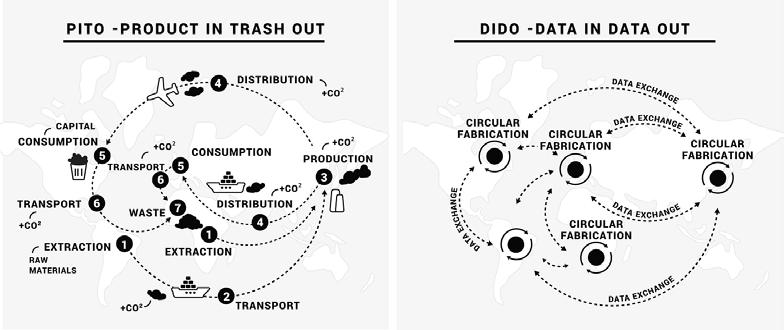
RE-proximate: integration between city and industry
Post-fossil urban principles



RE-proximate
Daily Urban System = walking and bicycle. All urban functions within 10 minute walk. RE-Industrial cities are car free.
RE-value
The area is characterized by extreme structures; sizes, processes and typologies. Some old building structures are repurposed, while other new structures are added
RE-cover
Large parts of the (former) site will be given back to the ecological system of the dunes, it will be approved by rewilding and reconnecting. In the urban part will be a grid implemented for thousends of trees to improve biodiversity and climate
R-ladder as spatial framework for a RE-Industrial city
R0 R1 R2 R3
R4
circular strategy circular space
RE-fuse
RE-think RE-duce RE-use RE-pair
Make product redundant by abandoning its function or by offering the same function with a radically different product
Make product use more intensive (example: by sharing product)
Increase efficiency in product manufacture or use by consuming fewer natural resources and materials
Reuse by another consumer of discarded product which is still in good condition and fulfils its original function
Repair and maintenance of defective product so it can be used with its original function
R7 R5
RE-furbish
R6
RE-manufacture
RE-purpose
R8 R9
RE-cycle RE-cover
Restore an old product and bring it up to date
Use parts of discarded product in a new product with the same function
Use discarded product or its parts in a new product with a different function
Process materials to obtain the same (high grade) or lower (low grade) quality
Incineration of material with energy recovery
CONSTRUCT MATERIAL CREATIVE SERVICE
Urban meaning of RE-Industrial spaces
CIRCULAR SPACE> CREATIVE - R0 R1 R2
EXPERIMENT RSITY
UNIVE
MUSEUM
CIRCULAR SPACE> CONSTRUCT - R5 R6 R7
FACTORY MATERIAL
CIRCULAR SPACE> MATERIAL R8 R9
ENERGY
One system of synergies

POSTFOSSIL
TATA STEEL
Essential steel only




Electric recycling (R8)



Iron material flows NL
Import: Iron ore, coal to IJmuiden
Export: 85% steel - 6 mln T per year from IJmuiden
Import 10.000 T scrap per day via harbours of Rotterdam
Produce 5000T scrap per day in NL collected and sorted in Moerdijk
Export >90% scrap per day From Moerdijk via Rotterdam (Turkey, Egypt, India) and Amsterdam (Europe)
IMPORTIRONORE

EXPORTSTEEL EXPORTSCRAP
Regional (NL) closed material (steel) system
5000T p/d
1,825 mln T p/y 45% less energy p/T
>97 / 100% reduction of emissions
Current Steel production Tata Steel
7 mln T p/y
85% production for export
34 billion liters clean water p/y
12,6 MT CO2 p/y (8% tatal emission NL)

Layout current steel factory
Layout current steel factory
Layout future steel factory
Layout future steel factory
RE-cover landscape
RE-cover landscape


RE-value building structure

RE-value spatial context: unbuilt - water + rail infrastructure suitable for LOGISTICS : remote (rail + water)


RE-value spatial context: large - extreme - long suitable for CONSTRUCT : R5 R6 R7

RE-value spatial context: small - complex - flexible
suitable for CREATIVE (experiment): R0 R1 R2


RE-value spatial context: characteristic - monumental suitable for SERVICE (& collective): R1 R3 R4
RE-value spatial context: energy waste infrastructure suitable for ENERGY (heat waste): R9




RE-value spatial context: open - large - campus
suitable for CREATIVE (innovation): R0 R1 R2

RE-value spatial context: low rise - light industry
suitable for CONSTRUCT : R5 R6 R7 (adapting in time)


RE-value spatial context: superindustrial - vertical suitable for PUBLIC - RE-creation program: culture/urban sport/leisure/health

RE-value spatial context: large - open - remote suitable for MATERIAL (steel + water): R8

RE-proximate city
10 minutes
RE-proximate zoning system
EXPERIMENTAL SPACE
existing building structures ‘occupied’ by artists, designers and pioneers + light, flexible structures added
R0-R1-R2
RADICAL SPACE
old industrial building structures tranformed into a vertical city, ‘floating’ above nature - residential, recreation, offices, industries, cultural
R0-R1-R2-R3-R4
CONSTRUCT SPACE
medium and large industrial processes + distribution transfer station, smaller industrial processes and housing on top
R5-R6-R7
SERVICE SPACE
monumental buildings for collective purposes + open but intimate blocks >residential, small industry, trade
R2-R3-R4
LOGISTIC SPACE
mainly non built area for rail distribution (freight station) and storage + public train stration + undefined space (lower part)
MATERIAL SPACE
steel (and water) recycling R8
LOGISTIC SPACE
rail distribution (freight station) and storage of materials + distribution transfer station
MEDIATION SPACE
medium and large industrial processes + rooftop-park with housing and other functions
R5-R6-R7
ADAPTIVE CONSTRUCT SPACE
existing industrial area will densify, mix and interact with both steel industry and university campus + housing
R5-R6-R7
CAMPUS SPACE
university campus + mix with housing, industry and other >permeable open green space
R0-R1-R2
RE-proximate micro-mobility network
10 minutes
RE-Industrial City

10 minutes


RE-industrial City
RE-MANUFACTORY + DISTRIBUTION
CARGO STATION
BOULEVARD
SLUISPARK
FACTORY
COLLECTIVE / COMMERCIAL
PIONEER + EXPERIMENT
SCRAPPARK

ATELIER MICRO LAB
RESIDENTIAL
EDUCATION
WORKSHOP
FACTORY
DISTRIBUTION
PAVILION
SHARED MICROMOBILITY
SHARED WORKSHOP
SHARED MATERIAL DEPOT
RESIDENTIAL (CPO)
COLLECTIVE / COMMERCIAL
WORKSHOP, STORE, SERVICE
HEAT WASTE
VISITOR EXPO
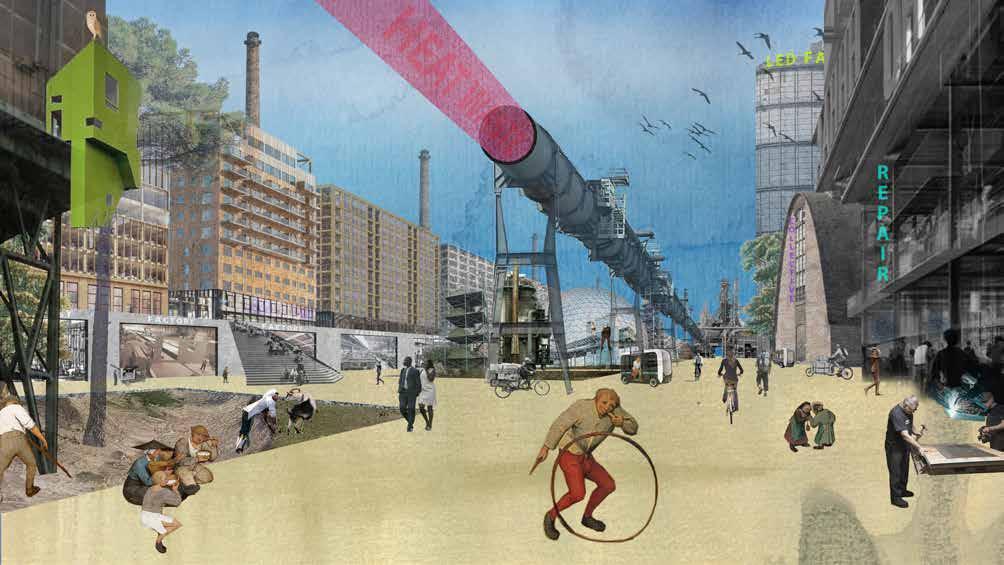

Radical change in 3 phases
PHASE 1

























> Start building Electric Arc Furnace






























> Electric Arc Furnace runs:













































> Electric Arc Furnace capacity maximized:





> Move buildings; make space for scrap area
> Placemaking (public events/experiments) on site
> Upscaling steel recycle system
> Downscaling fossil steel system
> Close Cokes factory 1, start urban development
> Start building processing factories
> Placemaking on energy site (future campus)
> Close all fossil factories (including energy)
> Transformation of two remaining factories
> Expansion of urban development
> Expansion of ecological areal
Interdependencies
in time
employment
economy
fossil factory
postfossil factory
city
well being & health
ecology
Radical change, who profits how?
Well being and health
surrounding residents
Clean environment - acces in local area - new jobs and urban program - environment of physical movement (bicycle, walking, outdoor sports)
Employees
Partly similar work in new factory, partly new jobs in new industries - no loss of jobs enduring tranformation
Company
Tata Steel
Clean production of steel, role model for transition and integration
Economy
Economic flows differently distributed: more local circulation and leveled in a network of activities locally added value to materials (manufacturing) - Total economic value of RE-industrial city is equal or higher than current value of Tata Steel NL
Ecology
Recovery of local eco-systems - radical reduction of carbon and zero air-, soil and water pollution - expansion of living areal and amound of species
Post-fossil Employment/ From large scale, centralised towards diverse, small scale, decentralised employment
Postfossil employment: from centralized, towards decentralized
RE-industrial City as new urban heart in a metropolitan region
Towards a RE-industrial community
Towards a RE-industrial community
Fossil industrial community (1955): THE TRIANGLE Post-fossil RE-industrial community: THE CIRCLE
Fossil industrial community (1955): THE TRIANGLE



2_(PRE-)FOSSIL LOGIC
small world, big systems

System scale follows energy


TIMEMAP OF ENERGY AND SOIL CITIES AUTOMOBILES

SOIL

 City as a (slow) water system
Travel time from London to New York by Otto Neurath (1940)
Transformation of agriculture
Amsterdam1800
Rotterdam Harbour1825
Rotterdam Harbour1800 Grand
Neurath (1940)
City as a (slow) water system
Travel time from London to New York by Otto Neurath (1940)
Transformation of agriculture
Amsterdam1800
Rotterdam Harbour1825
Rotterdam Harbour1800 Grand
Neurath (1940)
Travel

Transformation of agriculture

New York 40 days

potstal es kreupelbosjes heide vee beekdal
Wood harvesting, The Netherlands
40km

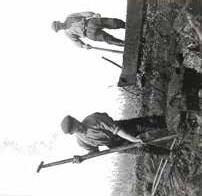
Peat digging, The Netherlands
Wind harvesting, The Netherlands














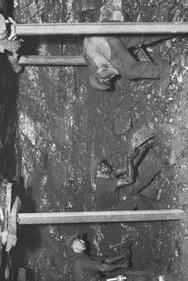











Founded for sovereignty of the Netherlands WW1


1 farmer x 10.000 1 pig x 1000.000







centrifuged, functions seperated




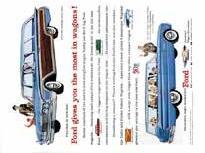






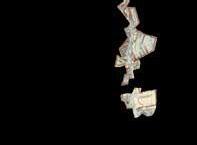






3 bln
















Ambition AmbitionIndia:

energy supply withdrawn from the recent past energy supply withdrawn from the far past underground materials needed for extraction and storage above ground

underground 82%
anno 2023: 85% export

large scale and singel orientated industries







‘The more the more consume, is a myth’




6% AmbitionChina:2060AmbitionIndia:2070


more energy available, more energy humans consume, sustainable growth myth’
 Arne Hendriks -
Jason Hickel -
Arne Hendriks -
Jason Hickel -



History: Dutch dunes as regenerative resource landscape, around 1600
Fishery Salt Sand Wood Hunting Cattle Small scale farming Sod
History: Relation between landscape and industry: Bleachers near dunes - due to clean water ca.1670
Gezicht op Haarlem uit het noordwesten, met de blekerijen op de voorgrond, Jacob van Ruisdael
History: 1853: Connection between the dune landscape (water) and the urban system of Amsterdam
Water basin Leiduinin Heemstede, built in 1853 by Amsterdamsche Duinwater Maatschappij
History: Start Hoogovens, 1924: NL becomes less dependent on other countries (urgency started in WW1)



TATA STEEL factsheet
7 mln tonnes steel p/y (NL)
8200 employees (NL)
Head office: Mumbai, India
Import: Iron ore, coal

Export: 85%: >160 countries
2,9 bln = 0,3% of total BNP in NL 2022 (BNP NL 2022: €943 bln)
12,6 MT CO2 p/y (8% tatal emission NL)
34 billion liters clean (tax free) water p/y

Iron material flows to and from NL

Pre-fossil Employment/ Colleborative, small scale, low-tech and handwork

Jevons Paradox - 1865: The more efficient a process becomes, the more the total energy demand rises


Fossil Employment/ Efficiency, machine work, centralisation of work in large factory

Fossil Employment/ Vulnurability of large scale and centralised industry


Fossil Employment/ Vulnurability of large scale and centralised industry

Fossil Employment/ Efficiency of industrial processes leads to less employment

Pre-fossil Well being & Health/ The Black Death and other epidemics spread across unsanitary Europe
No industrial pollution, sociability and short working hours (1350 - 1500)


Fossil Well being & Health/ Pollution and poor working conditions, but urban sanitary developped along



Fossil Well being & Health/ Tata steel, high numbers: cancer, insomnia, shorter life expectancy
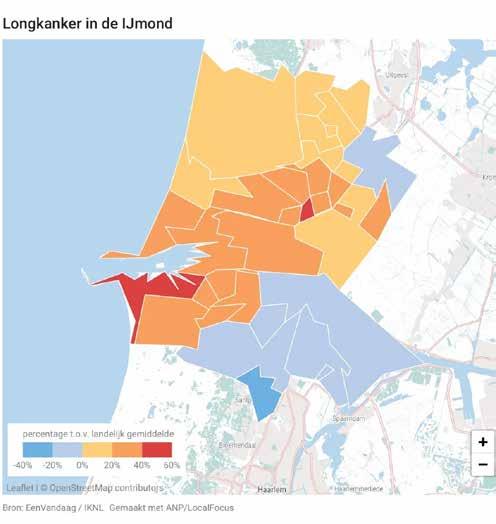

Fossil Well being & Health/ Well being above economy!


Source: Statista
Source: Less is More, Jason Hickel (page 224)
Pre-fossil Well being & Health/ City size follows modality; modality determines everyday life


Fossil Well being & Health/ Fossil cities have more cars
Change of modalities = change of everyday life


Source: PBL, CBS, OVG, MON, OViN, Schiphol, KiM
Source: Het Recht van de Snelste, De correspondent (2020), Thalia Verkade
Fossil cities have more cars, old and dense cities have less cars

(Pre-)Fossil Ecology/ From connected abundancy, to fragmented scarcity





3_POST-FOSSIL LOGIC
one
system of synergies
Post-fossil Economy: Glocalism: local production, global data

Post-fossil Economy: Local currencies add economic value to a region


Post-fossil Economy: Local currency = circular, more participants = more local value


Post-fossil Employment/ Building a car in Ghana by local craftsmen; reselience of informal micro industries

Post-fossil Employment/ Collaboration of 12.000 micro-businesses; a (circular) economy for over 90 years!

Post-fossil Employment/ Learning from: Genk (BE), C-Mine: diverse employment - culture, tourism and sience

Post-fossil Employment/ Learning from: Esch sur Elzatte (LUX), Belval: diverse employment - culture, tourism and sience (with EAF in back)

Post-fossil Employment/ From large scale, centralised towards diverse, small scale, decentralised employment
Post-fossil Well being & Health/ Homo Faber: The promise of collaborative work -
Jacob Lawrence and Richard Sennett
Post-fossil Well being & Health/ Homo Ludens: The promise of mechanization - Constant Nieuwenhuys

Post-fossil Well being & Health: Work (sociability) and Leisure (creativity) in balance!


Post-fossil Well being & Health/ Shorter working hours = more well being and health
WORKING HOURS
Post-fossil Well being & Health/ Plants, green space and particularly gardening, is beneficial to mental and physical health
Source: Nature - Spending at least 120 minutes a week in nature is associated with good health and wellbeing, 13-6-2019
Source: National Library of Medicine - Gardening for health: a regular dose of gardening, june 2018 Richard Thompson
Post-fossil Well being & Health/ Learning from: Genk (BE) and Duisburg (DE), Terrils as urban nature and urban sports

Source: www.nationaalparkhogekempen.be


Post-fossil Well being & Health/ City of hyper-poximity: pedestrian, bicycle and microbility
15 minute city - Paris

Source: Het Recht van de Snelste, De correspondent (2020), Thalia Verkade
Source: Stedenbouw, Kern en Perspectieven, 1ste druk, Boom (2020), Han Meyer, Maarten Jan Hoekstra, John Westrik pag 176
Source: Een constante in beweging? Reistijd, virtuele mobiliteit en de Brever-wet, Ministerie van Verkeer en Waterstaat (2001)
Everyday travel time of humans is 75 min (everywhere on earth)
Mobility scale follows energy



Post-fossil Economy: (mainly) car- and truck free
Post-fossil Ecology/ Humans and ‘nature’ are not seperated entities, but all part of one ecological system
IPPC report: half earth



Post-fossil Ecology/ Learning from: Duisburg (DE) and Charleroi (BE), post-fossil ecology
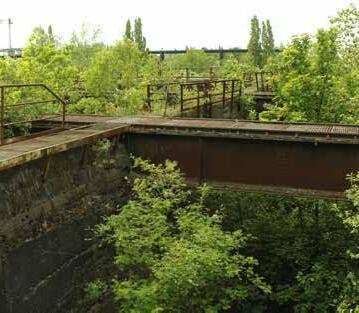



LITERATURE
Less is More, Jason Hickel. Hickel, J. (2020). Less is More: How Degrowth Will Save the World. Random House.
Het recht van de snelste. Verkade, T., & Brömmelstroet, M. C. G. (2020). Het recht van de snelste: hoe ons verkeer steeds asocialer werd.
De Blauwe Fabel. Joosten, T. (2022). De blauwe fabel: waarom we de KLM al een eeuw lang tegen elke prijs in de lucht houden.
Koop Lokaal Booster, Henk van Arkel. Stro, 2021
Eindeloze Wereld, Christophe Blain & Marc Jancovic. Concerto Books, 2022 Steel, C. (2013). Hungry City: How Food Shapes Our Lives. Random House.
Vertical Urban Factory, Nina Rappaport, 2020 (2th edition)
Hybrid factory, hybrid city. Rappaport, N. (2022). Hybrid factory, hybrid city. Nina Rappaport.
Stadsleven / Building and Dwelling, Sennett, R. (2018). Stadsleven: Een visie op de metropool van de toekomst. J.M. Meulenhoff.
Turtle 1: Building a car in Africa, Smets, M., Van Onna, J., & Oosterbaan, W. (2016). Turtle 1: Building a Car in Africa.
Een stuk grond op een unieke locatie, Groene Amsterdammer, 1-3-2023
Hoe Tata aan z’n plan werkte, NRC Handelsblad, 16-9-2023
De hoop van schroot, NRC Handelsblad, 13-1-2024
Terwijl grote techbedrijven duizenden werknemers ontslaan, komen er bij ‘groene’ startups juist banen bij, NRC Handelsblad, 5 december 2022
De groene industrie-boom in het hoge noorden, NRC Handelsblad, 3 december 2022
Hou zware industrie juist hier - maar ze moet wel schoner, NRC Handelsblad, 7 november 2022
Werkgelegenheid als chantagemiddel, Podcast Follow the Money, Thomas bollen en Ties Joosten, 30 oktober 2020
‘Als de staalfabriek sluit, duikt Taranto vijftig jaar terug in de tijd’, NRC Handelsblad, 3-2-2024
Miljoenen subsidie vervlogen in een grond luchtkasteel, NRC Handelsblad, 3-2-2024
‘Devasting’: Port Talbot steelworks to shut blast furnaces and shed up to 2800 jobs, The Guardian, 19-01-2024
GRADUATION TEAM
Academie van Bouwkunst Amsterdam, 2023 - 2024
Commision
Martin Probst (mentor)
Tess Broekmans
Merten Nefs
SPECIAL THANKS TO:
Martin Probst
Tess Broekmans
Merten Nefs
Maria Doelman
Ton van der Laaken
Karin Schacknat
Niels van Bunningen
Kilian Lode
Ashwin Karis
Ellis Soepenberg
RE-INDUSTRIAL CITY
scenario for a postfossil industrial society
